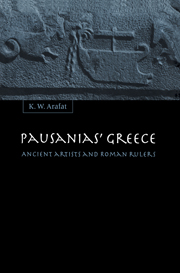Book contents
- Frontmatter
- Contents
- Map of Roman Greece
- Preface and acknowledgements
- List of abbreviations
- Chapter 1 Introduction
- Chapter 2 Pausanias on the past
- Chapter 3 Pausanias on the rulers of Roman Greece 1: introduction, Mummius and Sulla
- Chapter 4 Pausanias on the rulers of Roman Greece 2: Caesar and Augustus
- Chapter 5 Pausanias on the rulers of Roman Greece 3: Nero to Marcus Aurelius
- Chapter 6 Pausanias on Herodes Atticus and other benefactors
- Chapter 7 Conclusions
- Bibliography
- Index of Pausanias passages cited
- Index of other authors and passages cited
- General index
Chapter 3 - Pausanias on the rulers of Roman Greece 1: introduction, Mummius and Sulla
Published online by Cambridge University Press: 22 September 2009
- Frontmatter
- Contents
- Map of Roman Greece
- Preface and acknowledgements
- List of abbreviations
- Chapter 1 Introduction
- Chapter 2 Pausanias on the past
- Chapter 3 Pausanias on the rulers of Roman Greece 1: introduction, Mummius and Sulla
- Chapter 4 Pausanias on the rulers of Roman Greece 2: Caesar and Augustus
- Chapter 5 Pausanias on the rulers of Roman Greece 3: Nero to Marcus Aurelius
- Chapter 6 Pausanias on Herodes Atticus and other benefactors
- Chapter 7 Conclusions
- Bibliography
- Index of Pausanias passages cited
- Index of other authors and passages cited
- General index
Summary
INTRODUCTION
The following three chapters consider in detail the writings and attitudes of Pausanias concerning the ruling figures of Roman Greece. The first part of this chapter considers some of the criteria for selection which caused Pausanias to omit, or refer only briefly, to some of the emperors; the latter part concerns Pausanias' attitudes to Mummius and Sulla. Chapter 4 will concern Caesar and Augustus; and chapter 5 those emperors whom Pausanias discusses of the period from Nero to Marcus Aurelius, with particular emphasis on Hadrian.
The starting-point for these chapters is Mummius' destruction of Corinth in 146 bc, seen as a seminal moment in Greek history not only by modern scholars, but by Pausanias himself. There had, of course, been considerable earlier involvement of the Romans with Greece, and Pausanias has much to say on the Hellenistic period to 146 bc, besides his more widely acknowledged interest in Classical and earlier Greece. This was also the period when the Romans developed the habit of despoiling Greece of its art, a practice by no means original to them, as Pausanias was well aware (8.46.2; see below, p. 128), but one at which they became expert. The inglorious deeds of Marcellus at Syracuse in 211 bc are the most notable early example, and among the Romans ‘from that time came the very beginning of enthusiasm for Greek works of art and consequently of this general licence to despoil all kinds of buildings, sacred and profane’ (Livy 25.40.2; cf. Plut. Marc. 21.1).
- Type
- Chapter
- Information
- Pausanias' GreeceAncient Artists and Roman Rulers, pp. 80 - 105Publisher: Cambridge University PressPrint publication year: 1996

